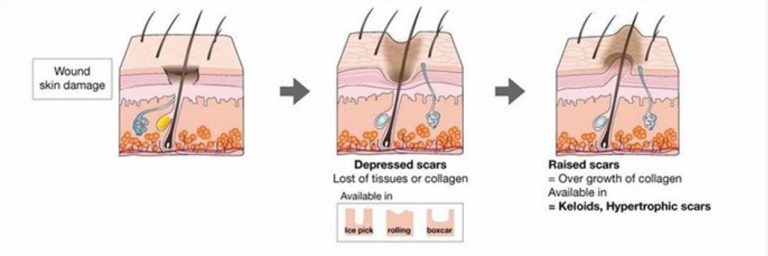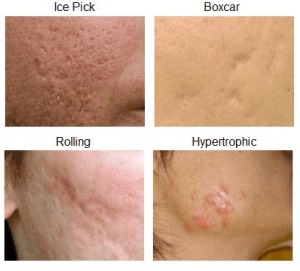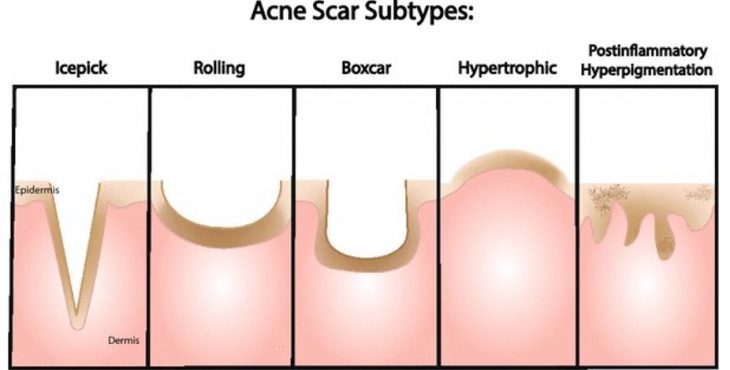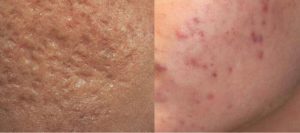

If you have any further questions or would like to chat, please contact us via any method below.
- 01603 291919
- info@thenorwichfaceandbodyclinic.co.uk
- Whatsapp Message Us




Acne scarring is the direct result of trauma from acne skin. Many factors can traumatise even small acne lesions resulting in scarring. Acne scars manifest as areas of pitted or raised skin. These can occur on the face or body. Not to be confused with PIE or PIH which are flat and temporary changes due to inflammation that tend to resolve over time; acne scarring changes the skin’s overall texture and, unfortunately, does not improve with time.
Acne scars result from the body’s natural attempt to heal itself. Skin pores will become clogged with dead skin cells and slowly fill with excess oil, which allows bacteria to grow. These pores or follicles can become engorged and result in acne lesions, such as whiteheads or blackheads. When these lesions rupture with the material spilling out onto the skin it causes irritation and inflammation which is seen as redness, tenderness and sometimes thick white fluid can appear from acne lesions.
When your pores become clogged with oil, dead skin cells, and other impurities your body has an inflammatory reaction that results in acne. Acne damages the deeper layers of the skin breaking down collagen (the glue of the skin) more often this results in scarring. When acne is close to the surface of the skin it usually heals with minimal damage to the skin.
An imperfect healing process forms an acne scar. Our skin is super clever, so to repair this issue, the skin will naturally form new collagen fibres. When the skin overproduces collagen raised acne scars occur. When insufficient collagen is produced pitted acne scars appear.
There are lots of acne types, some of which are more prone to scarring than others. Blackheads and whiteheads rarely result in scarring. Inflammatory acne types, such as acne cysts or nodules are unfortunately most likely to create long-term scarring, as this type of acne affects the more deeper layers of the skin.
Before treating your scars it’s essential to know what type they are. Each type responds to treatment differently, and some treatments are better for types than others.



Atrophic scars (depressed scars)
Atrophic scars are flat, shallow depressions that heal below the top layer of skin. These scars are commonly caused by severe cystic acne. However, other types of acne can cause them as well. The appearance of atrophic acne scars can vary depending on an individual’s history with acne. There are three types of atrophic scars:
Boxcar scars are broad, usually box-like depressions with sharply defined edges. Boxcar scars are caused by widespread acne, chickenpox, or varicella: a virus causing a red, itchy rash with blisters. Boxcar scars most often form on the lower cheeks and jaw, which is where the skin is relatively thick.
Ice pick scars are more minor and narrow indentations that point down into the skin’s surface. These scars are common on the cheeks. Ice pick scars tend to be very tough to treat and often require ongoing and aggressive treatment.
Rolling scars have varying depths with sloping edges that make skin appear wavy and uneven.
Hypertrophic and keloid scars (raised scars)
Unlike atrophic scars, Keloid and hypertrophic scars form as raised scar tissue where the acne once was. This happens when scar tissue builds up. Hypertrophic scars tend to be the same size as the acne that caused them. Keloid scars create a scar much larger than the acne that caused them and grow beyond the sides of the original spot. Keloid and hypertrophic scars tend to be more common in the jawline, chest, back, and shoulders. People with a darker skin tone are more likely to develop this type of scarring. The treatment of Keloid and hypertrophic scars remains challenging and may require visiting a dermatologist.
The most suitable treatments we offer to treat most acne scarring is:
If the scarring is mild we recommend the Focus Dual RF Microneedling;
The most suitable treatments we offer to treat hyperpigmentation is:
We also strongly recommend a personalised skincare product range and routine to be used for the duration of the treatment course (this is an absolute must when treating scarring). A 2–3-month skincare kit will be supplied, costing between £175 and £299, depending on the severity of the concern.


ACNE SCARRING VS HYPERPIGMENTATION


Hyperpigmentation refers to dark spots left behind after trauma to the skin/acne. Hyperpigmentation can also result from acne. This discolouration is not considered a scar but more of an acne stain.
If you are looking for an “acne scarring treatment near me” we offer two facials for these concerns. For mild scarring, we recommend the Focus Dual RF Microneedling; for deeper pitted scarring, we recommend the Fractional CO2 Laser Scar Resurfacing (please note we require a patch test for the CO2) If you would like to know more, please book a skin therapy consultation or skinscan analysis via the links.
If you have acne scars, you are not alone. Out of a huge 80% of people under 30 years old with acne, 20% of them will have acne scarring. Several factors contribute to whether or not you will be in that 20%, many of which are unavoidable:
Genetics: Some people are more prone to scarring than others. Not only from acne but other types of skin damage too. If you have a family history of scarring and/or acne scarring, then you should think about prioritising acne prevention.
Gender: Both men and women will deal with acne, but scarring is more common in men. Androgen hormones, which are more prevalent in men, make acne more persistent and severe.
Acne Severity: The more inflamed and deeper your acne, then the more likely it results in scarring.
Acne Persistence: If you leave the acne untreated and continue to suffer from breakouts, then the higher you are a risk for scarring.
Puberty: Teenagers are more prone to acne thanks to hormonal fluctuations. More acne and more frequent breakouts lead to a greater chance of scarring.
Sun Exposure: While sun exposure isn’t proved to necessarily cause more scarring: it can make the scarring more visible.
Scars will darken quicker than the surrounding skin, sometimes permanently.
Lack of Treatment: The longer you leave your acne without treatment, then the greater your risk of scarring.
Many may think they are washing and moisturising with over-the-counter products for “acne and scarring”, unfortunately over-the-counter skincare products have been designed to suit most of the population. They do this so not to negatively affect the general population’s skin. For this reason, the concentration of their active ingredients is relatively low and will have minimal effects on skin concerns such as acne, pigmentation, rosacea, and scarring.
Picking and Touching: Playing and picking at the spots and acne will cause trauma to the skin. Due to this, if you are picking spots, you are more likely to result in scarring and prolong the healing process.
As discussed above, acne scars form from acne, so acne prevention is essential. When and how you treat it is the main factor if you have acne.
See Acne to find out more.
Acne scars can affect confidence, self-esteem, and overall quality of life. The best first step is to treat any active acne lesions to prevent future scarring. However, if you are already left with scarring, many effective treatments can improve skin texture and reduce acne scarring.
Many people complain of acne scarring when they still have acne or PIE present. As above, it is essential to treat the inflammation first before the scarring.
The skin regenerates on a 28-day cycle. So, in 4 weeks the cells of your skin move from the bottom of the epidermis to the surface of your skin. The epidermis slows the loss of moisture from the dermis (the lower layer). This dermis is made up of collagen and elastin. It’s important to keep it hydrated as this keeps your skin more elastic, healthier, and youthful. A proper skincare routine is essential to achieving and maintaining a healthy skin barrier.
SKINCARE PRODUCTS:
Over-the-counter skin care products have been designed to suit most of the population. They do this so not to affect the skin of the general population negatively. For this reason, the concentration of their active ingredients is relatively low and will give minimal effects on skin concerns such as acne, pigmentation, rosacea, and scarring.
Our products are made with more potent ingredients and can only be purchased or prescribed by myself (an advanced skin specialist) or Dr Shah (One of our clinic doctors). They have been developed and researched to the point that they have sufficient active ingredients to make changes in your skin. A higher amount of the active ingredient = better quality and results!
In addition, to having a higher active ingredient content, our products are made using the latest technology and can be adapted to your skin issues.
Over-the-counter products are designed to sit on the surface of the skin, whereas our products have been designed to penetrate the epidermis and affect deeper layers of the skin.
Advice from our Skin Specialists
“Be mindful that it takes time and commitment to see those all-important changes to your skin. Think of your in-clinic appointments and home skincare regime in the same way as exercising – it takes consistency and maintenance to see positive and lasting results. We are confident that by having regular appointments with us and doing your bit at home, we can help you achieve your best skin!”
Lauren and Rebecca.
If you are looking for the “best treatment for acne scarring” and you are still not sure which facial you need? Send us a WhatsApp message with a variety of clear images of the treatment area, and we will recommend the most suitable treatment.



 Tues–Sat
Tues–Sat
